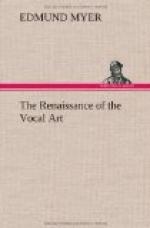Remember the most important point is the movement from repose to the level of the tone. If this is done according to directions, all restraint will be removed and all true conditions will prevail. Never influence form. Let form and adjustment be automatic, the result of right thought, position, and action. Study to constantly make these movements of the body easier and more natural. Take off all effort. Do not work hard. It is not hard work. It is play. It is a delight when properly done. Make no conscious, direct effort of any part of the body. Never exaggerate the movement or action of one part of the body at the sacrifice of the true position of another. The tendency is to locally raise the chest so high that the abdomen is unnaturally drawn in. This, of course, is the result of local effort, and is not the intention of the movements. The center of gravity must be at the hips; and all movement above that must be free, flexible, and uniform.[1]
[Footnote 1: In this connection, see Supplementary Note, page 135.]
Do not give a thought to any wrong thing you may be in the habit of doing in singing, but place your mind upon freeing the voice, upon the removal of all restraint through these flexible vitalized movements: think the ideal tone and sing. When the right begins to come through these movements the wrong must go. Over and against every wrong there is a right. We remove the wrong by developing the right. Sing in a free, flexible manner, the natural power of the voice. Make no effort to suppress the tone or increase its power. After the movements are understood and all restraint is removed, then study the tone on all degrees of power, but remember when singing soft and loud, and especially loud, that the first principle of artistic singing is the removal of all restraint.
ARTICLE TWO.
THE SECOND PRINCIPLE OF ARTISTIC TONE-PRODUCTION.
The second principle of artistic tone-production is
Automatic Breathing and Automatic Breath-Control.
Theory.—The singing breath should be as unconscious,—or, rather, as sub-conscious,—as involuntary, as the vital or living breath. It should be the result of flexible action, and never of local muscular effort. The muscular breath compels muscular control; hence throat contraction. The nervous breath, nervous control; hence relaxation and loss of breath.
Devices.—Expand to breathe. Do not breathe to expand. Expand by flexible, vitalized movements; control by position the level of the tone, and thus balance the two forces, “pressure and resistance.” In this way is secured automatic adjustment and absolute automatic breath-control.




